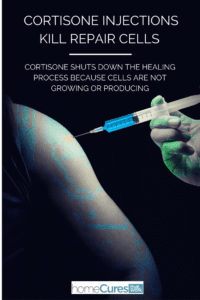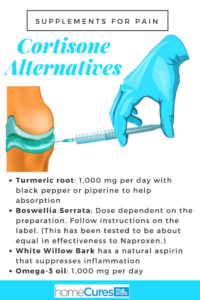Cortisone Injections – What You Need to Know
Isaac had surgery on his shoulder, but it wasn’t successful. He still has weakness and is unable to lift his arm past 90 degrees on the side. The surgeon said the torn tendons of the shoulder are not repairable because they are too soft. There isn’t enough strength in the tendons to hold the sutures needed to repair it. His only option now is to have a graft from an outside tendon. Read on to find out what caused Isaac’s condition.
Is Cortisone a Panacea?
Cortisone in a powerful hormone produced in the adrenal glands. It is a natural substance essential for the body to function – without cortisone we will die. This hormone signals almost every cell in the body to know what to do. It tells the cells to wake up during the day. Then cortisone reduces itself at night to bring on sleep, and rest. We need it to be there when we need it, but go away when we don’t need it.
One of the greatest functions of cortisone is to suppress inflammation, pain, redness, itching, tenderness, or damage caused by injury, infection, or allergic reactions.
Since inflammation is the primary cause of aging and disability, cortisone should be the best thing to happen to mankind. It is so good that all of the following problems could be treated with cortisone:
- Arthritis
- Allergies
- Eczema
- Ulcerative colitis
- Addison’s disease
- Lupus
- Trauma
- Shock
- Psoriasis
- Asthma
- Rheumatic conditions
- Cancer
- Brain swelling
- Autoimmune diseases
- Reactions
- Infections[1]
Reading this list can make people believe that cortisone is a cure-all and that it can fix anything. Indeed, inflammation is a big cause of disease. Cortisone suppresses inflammation, therefore it should be very useful.
Trouble in paradise
However, not all is rosy with this very powerful hormone. Yes, cortisone suppresses inflammation to reduce pain, redness, tenderness and heat. BUT, this effect is temporary. The long-term effects of suppressed inflammation include the inability to heal, an increase in chronic pain and problems later. This is because cortisone is a catabolic hormone, meaning it breaks down tissue.
One study showed both the lack of blood vessels and other signs of healing after a cortisone injection into a shoulder joint, as well as evidence of toxicity that destroys the tendons.[2] Another study showed that tendon cells no longer reproduce (in other words, cannot heal) with a tenth of the normal dose of a common synthetic cortisone called Triamcinolone. The normal dose caused irreversible death of the tendon cells.[3]
The fact was, Isaac’s surgeon was unable to repair his shoulder because of too many cortisone injections in the past. His tendons were breaking-down and were too weak to even be stitched together!
In fact, the list of problems associated with the use of cortisone, especially injections includes:[4]
- Joint infection
- Nerve damage
- Thinning of skin and soft tissue around the injection site
- Temporary flare of pain and inflammation in the joint
- Tendon weakening or rupture
- Thinning of nearby bone (osteoporosis)
- Whitening or lightening of the skin around the injection site
- Problems with vision
- Swelling
- Rapid weight gain
- Severe depression
- Unusual thoughts or behavior
- Seizures (convulsions)
- Bloody or tarry stools
- Coughing up blood
- Pancreatitis
- Low potassium
- Dangerously high blood pressure
- Buzzing in the ears
- Anxiety
- Confusion
- Chest pain
- Shortness of breath
- Uneven heartbeats
- Sleep problems (insomnia)
- Acne, dry skin
- Bruising or discoloration
- Slow wound healing
- Increased sweating
- Dizziness, spinning sensation
- Changes in the shape or location of body fat
- Increase in blood sugar
- Memory lapse
Cortisone and Diabetes
Cortisone is a glucocorticoid hormone. In other words, it is a steroid hormone that regulates blood sugar. Here is how it works. We release cortisone under stress, which increases our blood sugar and gives us quick energy. Cortisone makes some cells more resistant to insulin. This is so the heart and brain cells can have more energy. This may sound like a good idea, but over time it wreaks havoc on our metabolism. Cortisone changes the ability of our cells to make energy.
People who use cortisone or its derivatives become increasingly insulin resistant. This leads to obesity, diabetes, and fatigue. Those who have just one cortisone injection may have a transient increase in blood sugar, but long-term use may make it permanent.
Cortisone and Obesity
Cortisone causes obesity by the same mechanism. The cells are resistant to insulin, causing the blood sugar to rise, which tells the pancreas to put out extra insulin. This extra insulin tells the fat cells to store more fat, and obesity is inevitable. Worse, it isn’t just storing more fat. Excess cortisone causes leptin resistance that tells the body to eat more, while at the same time causing a craving for carbohydrates. These factors in combination are deadly! There is no way out. After a while, even if excess cortisone is stopped, the insulin will remain high and the obesity cycle will continue.
Cortisone and Pain
Cortisone increases a receptor in the tissues called glutamate, which mediates pain sensation. After a cortisone injection, the tissues may continue to feel pain, even though there is no inflammation. Some end up with chronic pain because of the cortisone.
Cortisone and Tissue Breakdown
Because it is a catabolic hormone, cortisone breaks down tissue. As with Isaac’s example above, cortisone kills the cells that repair the tissues. This causes the tissues to weaken. Which is why surgeons do not want to operate on shoulders that have had multiple cortisone injections. The tendons are too weak to hold sutures.
A common side effect of cortisone is thinning of the skin. Usually damaged skin cells release factors that recruit healing. Inflammation is a temporary result while collagen and protein heal injured tissue. But extra cortisone shuts down the healing process, leaving skin friable and easily damaged. Furthermore, those taking cortisone also have slow healing because the cells are not growing or producing. The result is that the weakened tissues stay in the weakened state for a longer period of time. Cortisone compromises the integrity of your skin.
Cortisol and Brain Dysfunction
Even a single shot of cortisone can affect the brain and all forms of cortisone are included. Some people get euphoria, while others may get hallucinations and delusions. It seems to cause depression in about 40% of people. Many also have insomnia when taking cortisone. The worst effect of cortisone on the brain is atrophy. The hippocampus and amygdala, where memory and emotions originate are the primary areas of shrinking, leading to possible Alzheimer’s disease.[5]
The Message
I have told you how amazing cortisone is to save lives. Cortisone can remedy a case of an acute reaction, get rid of terrible pain or treat skin rashes. Yet we read all the side-effects and wonder why anyone would ever use this hormone.
This is why treatment of health issues is an art rather than an exact science. The wise and judicious use of this very powerful hormone can be a real benefit. It should be understood and used with caution, good judgment, and skill. It should be used where it will provide a long-term benefit, not just relieve a symptom temporarily.
How to Properly Use Cortisone
A man came in with a rash on his shoulder that was round, scaly and itchy. I gave him a cortisone cream, which cleared the rash. But when he stopped using it, the rash returned. He came back and I gave him a stronger cream, but the same thing happened. We then had to start looking for the culprit. Why was he getting this rash? It’s well-known that rashes on the skin are often caused by inflammation in the intestines. So we used the “elimination diet” and removed various foods to see if the rash would go away. Nothing worked. We then turned to his medications.
He had been on a blood pressure medication for over ten years. He told me that couldn’t be the problem, but I insisted he try it. He went off the medication and the rash disappeared. He didn’t believe it so he went back on the medication and the rash returned exactly the way it was before. He finally relented and stopped the medication. His rash resolved and never returned.
If there is an inflammation that is temporary, cortisone may be the way to resolve it. For example, if there is an itchy rash from poison oak that should go away in a couple of weeks, then cortisone might be helpful. However, if a chronic reaction should occur, cortisone would not be a good choice.
Chronic joint pain like shoulders, knees, and backs are other examples to forego cortisone. Cortisone, especially by injection, helps only temporarily. And it may lead to other problems, as we have discussed.
Cortisone Alternatives
There are many alternatives to cortisone for long-term problems. The key in every case is to find the cause of the inflammation first and remove it. Then cortisone, or any other anti-inflammatory drug or supplement, won’t be necessary.
The first place to look is the diet. Most internal reactions will have some sort of external manifestation. People with chronic allergies are generally helped by the “elimination diet.” This finds the food or medications that might cause an inflammatory reaction. Reactions to food in the intestines will cause different inflammatory issues in different people. An elimination diet works well to pinpoint psoriasis, dandruff, eczema, and joint pain triggers.
Next, look at the environment. Some people react to pollen, dust, and other environmental triggers, creating the same inflammatory issues. Sometimes avoiding them or using desensitization techniques will be very helpful.
When these measures fail, there are several supplements that can help a great deal:
- Turmeric root: 1,000 mg per day with black pepper or piperine to help absorption
- Boswellia Serrata: Dose dependent on the preparation. Follow instructions on the label. (This has been tested to be about equal in effectiveness to Naproxen.)
- White Willow Bark has a natural aspirin that suppresses inflammation
- Omega-3 oil: 1,000 mg per day
For joint pain, consider doing the following instead of cortisone injections:
- MSM: 1000mg three times per day
- Glucosamine: 500mg three times per day
- Vitamin C: 1000 mg three times per day
An excellent way to begin joint healing is to do a bone broth “cleanse.” There are many ways to do this, but I have found the 2-day-per-week method to work well. And it is more easily done than doing it for weeks or months!
The bone broth cleanse is restricting one’s diet to bone broth only for two days every week. You can do the two days together or split them up. For the other days, continue to drink bone broth – about a quart per day – but you can eat other foods as well. I have had many patients do this successfully. (If they have a lot of inflammation, they sometimes start with two weeks of only bone broth.)
Yesterday, I had a patient return six months after she was scheduled for a knee replacement surgery. She didn’t need the new knee, and she’s walking well!
Cortisone kills cells – it’s dangerous, and should be used very carefully. Isaac is still looking at a lot of surgery which may not work. It’s so much better to heal the problem instead of just suppressing inflammation. If you can use any of these other means of lowering inflammation and repairing the body, it would give you so much more long-term benefit!




















